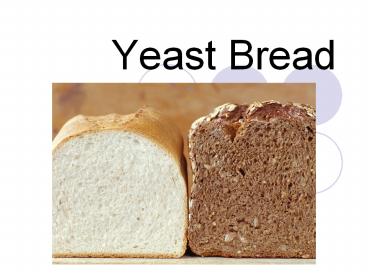Yeast Bread - PowerPoint PPT Presentation
Title:
Yeast Bread
Description:
Yeast Bread What are the three classes of yeast breads? a. Rolls b. Loafs c. Doughnuts INGREDIENTS AND FUNCTIONS IN A YEAST BREAD INGREDIEN T FUNCTION FLOUR STRUCTURE ... – PowerPoint PPT presentation
Number of Views:904
Avg rating:3.0/5.0
Title: Yeast Bread
1
Yeast Bread
2
- What are the three classes of yeast breads?
- a. Rolls
- b. Loafs
- c. Doughnuts
3
INGREDIENTS AND FUNCTIONSIN A YEAST BREAD
INGREDIEN T FUNCTION
FLOUR STRUCTURE, FORMS GLUTEN
YEAST LEAVENING AGENT
LIQUID MOISTEN
SALT FLAVOR
SUGAR FOOD FOR THE YEAST
FAT TENDERNESS AND RICHNESS
EGGS STRUCTURE, FLAVOR, RICHNESS
4
- What is the difference between quick and yeast
breads? - Quick breads quick and easy to prepare, use
baking powder or soda as leavening agent. - Yeast breads uses yeast, longer to prepare.
5
Characteristics of Yeast
- 1. Is a living organism
- 2. Must have warmth, moisture and food
6
- How does the temperature of water affect the
growth of yeast? - Hot kills the yeast, unleavened bread
- Cold retards the growth, slows it down
7
- Why would you want to scald the milk?
- It inactivates the enzymes so the dough is
easier to handle and not as sticky. - How do you know your milk is scalded?
- Bubbles form around the outer edge. Feel a scum
on the bottom of a pan with a spoon.
8
- What are the differences between the
straight-dough method, the sponge-dough method,
or the batter, or no-knead, method in mixing
yeast dough? - Straight dough all ingredients are combined and
the dough is kneaded and set aside to rise. - Sponge dough yeast is combined with part of the
liquid, flour and sugar to make a batter. Let
rise until light and bubbly, then add remaining
ingredients to make a stiff dough. - Batter or no-knead all the ingredients are
combined, but the dough is not kneaded.
9
Food Science Principles of Yeast Breads
- Fermentation
- The process in which yeast breaks down sugars
into energy. - Longer and slower fermentation time better
flavor. - Change the rate of fermentation
- Temperature of dough.
- Amount of salt.
- Amount of sugar
- Amount of yeast.
10
Food Science Principles of Yeast Breads Cont.
- Kneading
- Enables the yeast to be distributed throughout
the dough. - Helps the proteins in the flour to develop
gluten. - Too much kneading will cause dough to loose
flavor after being baked. - Stretch test
- Stretch dough to see if it has been kneaded long
enough. - It should resemble bubblegum.
11
- What is gluten?
- Protein part of flour, when mixed with a liquid,
kneaded and developed sufficiently, gives the
dough its framework and structure. The amount is
different in each type of bread.
12
Food Science Principles of Yeast Breads Cont.
- Proofing
- Period of leavening (rising) of dough preceding
baking. - Usually let dough proof/raise until it doubles in
size.
13
- What is the ripe test?
- When the dough has doubled in volume, put your
two fingers in the middle of the dough if your
imprint remains, the dough is ready to shape - How are refrigerator dough and regular roll
dough different? - Refrigerator dough has more sugar and yeast in
recipe so it will stay good in the refrigerator 4
5 days
14
Food Science Principles of Yeast Breads Cont.
- Shaping Using the hand to mold the dough into
the shape or loaf or rolls - How do you shape a loaf of bread?
- Roll out in a rectangle to remove air bubbles
- Roll up in jelly roll
- Pinch seam together
- Push in insides
- Karate chop and, tuck underneath
- Place in bread pan seam side down
15
Baking/Oven Spring
- Use the correct temperature
- Choose the correct size pan
- Prepare the pans
- Bake product
- Oven spring last jump is size before the yeast
is killed
16
- How do you place your rolls on a cookie sheet
if you want soft sides? - Place them close together on cookie sheet
- Crusty sides?
- Place them far apart on cookie sheet
17
- Where is the bread placed in the oven?
- Center of oven
- How do you tell if the bread is baked thoroughly?
- Tap it lightly with hand. If it sounds hollow,
it is done
18
- What do you do with the bread after it is baked
and it comes out of the oven? - Immediately, remove the bread from the pan so it
doesnt sweat and become soggy
19
- How do you store yeast breads?
- Covered container or bread box to prevent drying
and loss of freshness. Refrigeration retards
spoilage by mold. Freeze.































